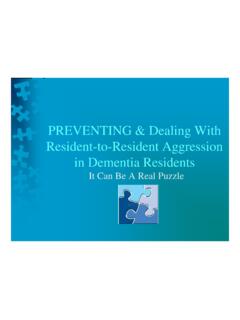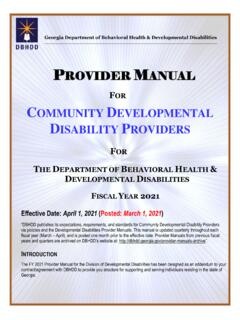Transcription of RUG-IV 66-Group Model Calculation Worksheet for SNFs
1 RUG-IV 66-Group Model Calculation Worksheet for SNFs Page 1 of 29 October 12, 2010 The purpose of this RUG-IV Version Calculation Worksheet for the 66-Group Model is to provide a step-by-step walk-through to manually determine the appropriate RUG-IV Classification based on the data from an MDS assessment. The Worksheet takes the grouper logic and puts it into words. We have carefully reviewed the Worksheet to ensure that it represents the standard logic. In the RUG-IV 66-Group Model , there are 23 different Rehabilitation Plus Extensive Services and Rehabilitation groups, representing 10 different levels of rehabilitation services.
2 In the 66-Group Model , the residents in the Rehabilitation Plus Extensive Services groups have the highest level of combined nursing and rehabilitation need, while residents in the Rehabilitation groups have the next highest level of need. Therefore, the 66-Group Model has the Rehabilitation Plus Extensive Services groups first followed by the Rehabilitation groups, the Extensive Services groups, the Special Care High groups, the Special Care Low groups, the Clinically Complex groups, the Behavioral Symptoms and Cognitive Performance groups, and the Reduced Physical Function groups. There are two basic approaches to RUG-IV Classification: (1) hierarchical classification and (2) index maximizing classification.
3 The current Worksheet was developed for the hierarchical methodology. Instructions for adapting this Worksheet to the index maximizing approach are included below (see Index Maximizing Classification ). Note that the RUG classification used for Medicare PPS Part A billing is based on the index maximizing approach. Hierarchical Classification. The present Worksheet employs the hierarchical classification method. Hierarchical classification is used in some payment systems, in staffing analysis, and in many research projects. In the hierarchical approach, start at the top and work down through the RUG-IV Model ; the assigned classification is the first group for which the resident qualifies.
4 In other words, start with the Rehabilitation Plus Extensive Services groups at the top of the RUG-IV Model . Then go down through the groups in hierarchical order: Rehabilitation Plus Extensive Services, Rehabilitation, Extensive Services, Special Care High, Special Care Low, Clinically Complex, Behavioral Symptoms and Cognitive Performance, and Reduced Physical Function. When you find the first of the 66 individual RUG-IV groups for which the resident qualifies, assign that group as the RUG-IV classification. If the resident qualifies in the Extensive Services group and a Special Care High group , always choose the Extensive Services classification because it is higher in the hierarchy.
5 Likewise, if the resident qualifies for Special Care Low and Clinically Complex, always choose Special Care Low. In hierarchical classification, always pick the group nearest the top of the Model . Index Maximizing Classification. Index maximizing classification is used in Medicare PPS (and most Medicaid payment systems) to select the RUG-IV group for payment. There is a designated Case Mix Index (CMI) that represents the relative resource utilization, for each RUG-IV group . For index maximizing, first determine all of the RUG-IV groups for which the resident qualifies. Then, from the qualifying groups, choose the RUG-IV group that has the highest CMI.
6 For Medicare PPS, the index maximizing method uses the CMIs effective with RUG-IV implementation on October 1, 2010. While the following Worksheet illustrates the hierarchical classification method, it can be adapted for index maximizing. For index maximizing, evaluate all classification groups rather RUG-IV 66-Group Model Calculation Worksheet for SNFs Page 2 of 29 October 12, 2010 than assigning the resident to the first qualifying group . In the index maximizing approach, again start at the beginning of the Worksheet . Then work down through all of the 66 RUG-IV Classification groups, ignoring instructions to skip groups and noting each group for which the resident qualifies.
7 When finished, record the CMI for each of these groups. Select the group with the highest CMI. This group is the index-maximized classification for the resident. Non- therapy Classification. In some instances, the SNF provider may be required to report, on the SNF Medicare claim, a non- therapy RUG-IV classification according to the SNF PPS policies (as noted elsewhere in this chapter, Chapter 8 of the Medicare Benefit Policy Manual, and Chapter 6 of the Medicare Claims Processing Manual). The non- therapy classification uses all the RUG-IV payment items except the rehabilitation therapy items (O0400A,B,C) to determine a non- therapy , clinical RUG.
8 To obtain a non- therapy RUG with this Worksheet , skip Category I (Rehabilitation Plus Extensive Services) and Category II (Rehabilitation) and start with Category III (Extensive Services). Both the standard Medicare Part A RUG reported in Item Z0100A and the Medicare Part A non- therapy RUG in Item Z0150A are recorded on the MDS When rehabilitation services are not provided, the standard Medicare Part A RUG will match the Medicare Part A non- therapy RUG. RUG-IV 66-Group Model Calculation Worksheet for SNFs Page 3 of 29 October 12, 2010 RUG-IV 66 Classification System Version Rehabilitation + Extensive Rehabilitation Extensive Services Special Care Low Special Care High Clinically Complex Behavioral Symptoms & Cognitive Performance Reduced Physical Function RUG-IV 66-Group Model Calculation Worksheet for SNFs Page 4 of 29 October 12.
9 2010 RUG-IV 66 group Classification Version RUG RUG Ultra High 2-10 RUL 11-16 RUX Very High 2-10 RVL 11 -16 RVX High 2-10 RHL 11-16 RHX Medium 2-10 RML 11-16 RMX Low 2-16 RLX RUG RUG RUG Ultra High 0-5 RUA 6-10 RUB 11-16 RUC Very High 0-5 RVA 6-10 RVB 11-16 RVC High 0-5 RHA 6-10 RHB 11-16 RHC Medium 0-5 RMA 6-10 RMB 11-16 RMC Low 0-10 RLA 11-16 RLB care 2. Ventilator/Respirator RUG RUG RUG 3. Infection Isolation 1 and 2 ES3 1 or 2 ES2 3 ES1 (while a resident) RUG RUG RUG RUG (ADL) 2-5 6-10 11-14 15-16 YES HB2 HC2 HD2 HE2 NO HB1 HC1 HD1 HE1 RUG RUG RUG RUG (ADL) 2-5 6-10 11-14 15-16 YES LB2 LC2 LD2 LE2 NO LB1 LC1 LD1 LE1 RUG RUG RUG RUG RUG (ADL) 0-1 2-5 6-10 11-14 15-16 YES CA2 CB2 CC2 CD2 CE2 NO CA1 CB1 CC1 CD1 CE1 RUG RUG RUG RUG RUG (ADL) 0-1 2-5 6-10 11-14 15-16 YES PA2 PB2 PC2 PD2 PE2 NO PA1 PB1 PC1 PD1 PE1 RUG RUG (ADL)
10 0-1 2-5 YES BA2 BB2 NO BA1 BB1 Rehabilitation + Extensive Rehabilitation ADL 2-16 ADL 0-16 Extensive Services ADL 2-16 Special Care High ADL 2-16 Depressed Special Care Low ADL 2-16 Depressed Clinically Complex ADL 0-16 Depressed Behavioral Symptoms & Cognitive Performance ADL 0-5 Restorative Nursing Reduced Physical Function ADL 0-16 Restorative Nursing Calculation OF TOTAL ADL SCORE RUG-IV , 66 group HIERARCHICAL CLASSIFICATION Page 5 of 29 October 12, 2010 The ADL score is a component of the Calculation for placement in all RUG-IV groups. The ADL score is based upon the four late loss ADLs (bed mobility, transfer, toilet use, and eating); and this score indicates the level of functional assistance or support required by the resident.







